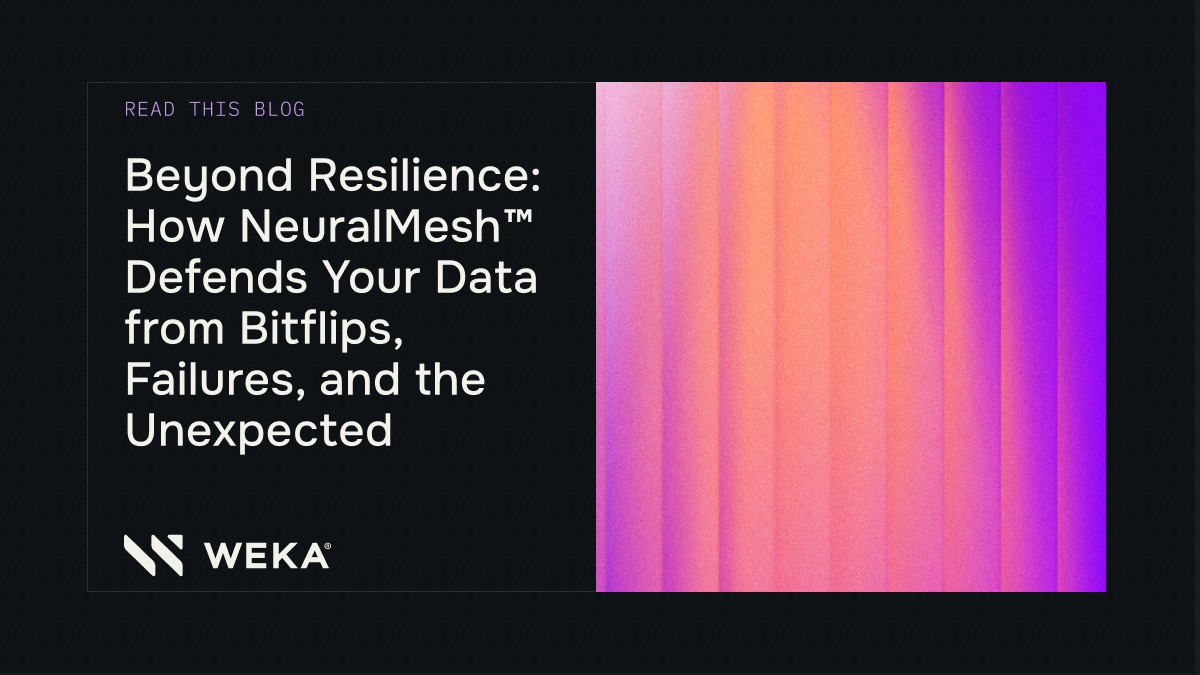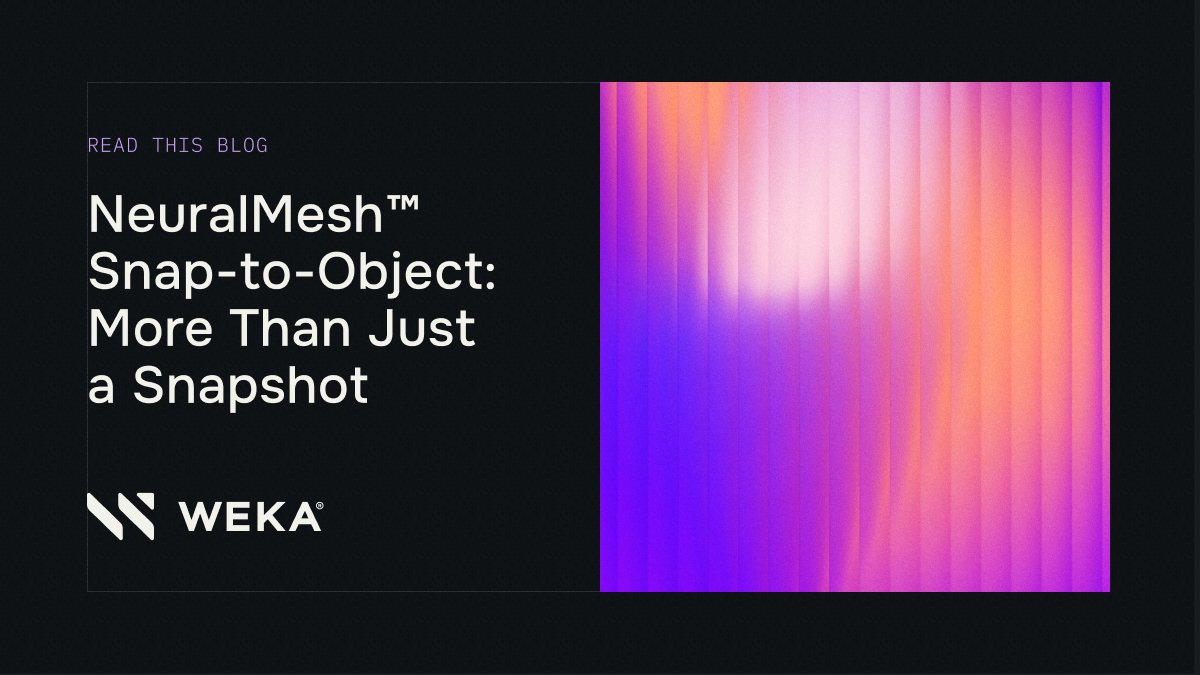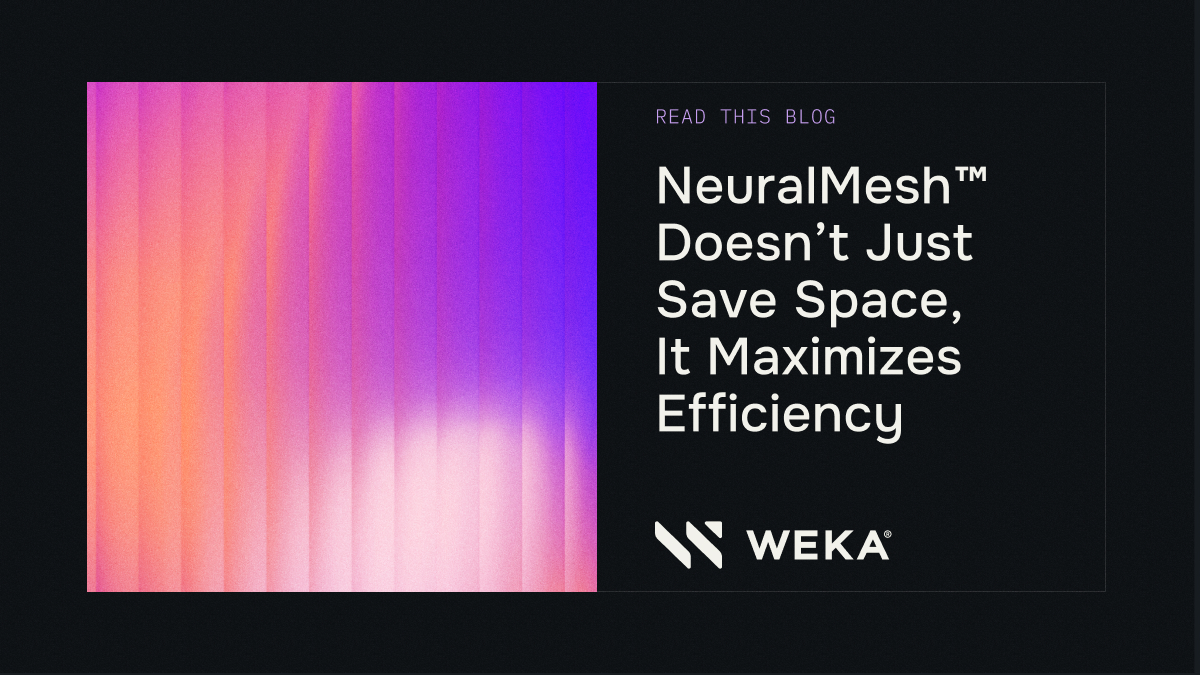Efficient Multitenancy: How WEKA Solves Modern Cloud Challenges
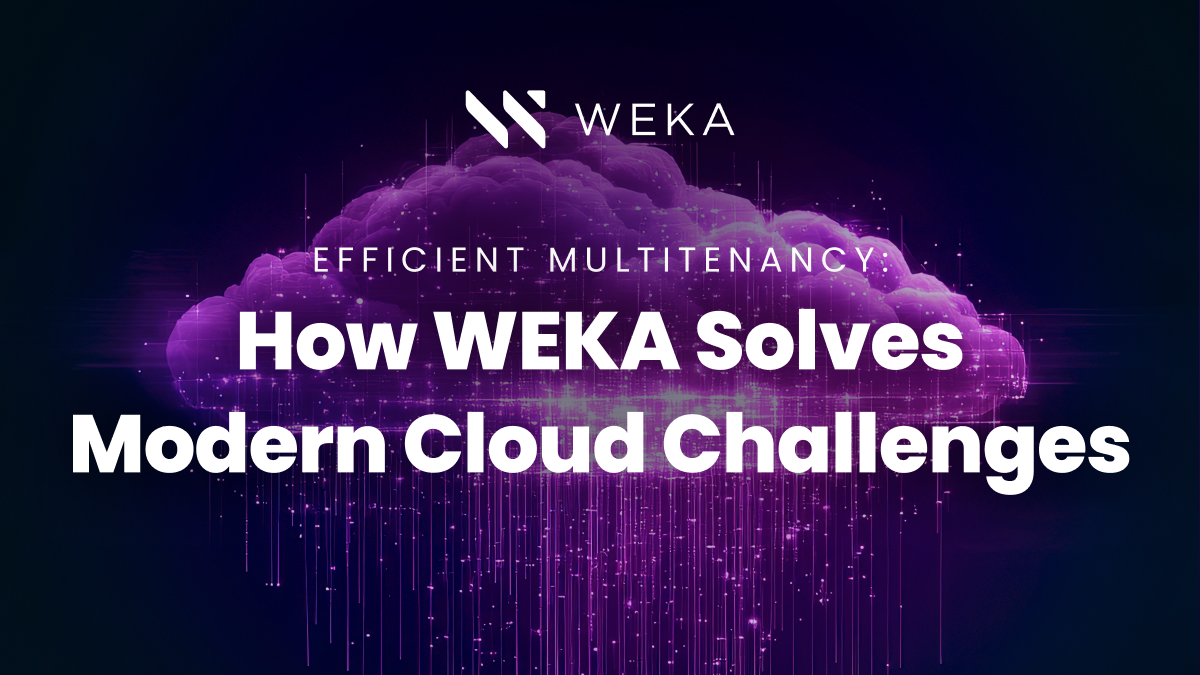
Imagine how the world would look to a service provider if they didn’t have multitenancy. Every time someone wants to use a cloud service, the provider has to build an entirely new data center just for them. So, you sign up for a cloud storage service, and suddenly, there’s a crew outside your house, frantically constructing a building just to store your cat photos. Every time you upload a new picture, they have to expand the building, leading to entire neighborhoods being taken over by mini data centers, each dedicated to a single user’s files. It’s like everyone having their own personal post office that delivers only their mail—absurd, inefficient, and definitely a bit chaotic.
The promise of multitenancy in a shared cloud architecture is one where multiple customers share the same infrastructure and resources, while keeping their data and operations isolated to preserve privacy and performance. Think of it as a “family plan” for something like a streaming service. Each family member can turn on the TV or other device and choose their profile, and their saved shows and suggestions are unique to the behaviors of that family member, but every other family member has isolated settings, saved shows, etc…
This approach maximizes resource efficiency, reduces costs, and enables scalable, flexible, and secure cloud services. It is more important today than ever, largely due to the growing demand for cloud services. As more businesses migrate to the cloud, the need for scalable and efficient solutions has skyrocketed. Multitenancy allows a new breed of Cloud Service Providers (CSPs) to support a large and diverse customer base without building separate infrastructure for each client. This shared model enables CSPs to manage the increasing demand effectively and cost-efficiently, making cloud services more accessible to a broader range of businesses.
What Makes for Good Multitenancy?
The rapid emergence of GPU Cloud Service Providers has transformed the landscape of high-performance computing, enabling businesses and researchers to access powerful GPU resources on-demand without the need for expensive, on-premise infrastructure. With the explosion of AI, machine learning, and data-intensive applications, the ability to leverage scalable GPU power in the cloud has become crucial for accelerating innovation and reducing time-to-insight. These specialty providers offer GPU instances that support deep learning, large-scale simulations, and real-time analytics, allowing organizations to efficiently process massive datasets and train complex models. As AI-driven technologies continue to advance, GPU Cloud Service Providers play a vital role in making cutting-edge compute power accessible and scalable for enterprises of all sizes.
Cost efficiency is a top priority in today’s competitive GPU Cloud market, and multitenancy plays a critical role in reducing the costs of cloud services. By sharing infrastructure among multiple tenants, these CSPs can lower their operational expenses, which translates into more affordable services for customers. This is particularly beneficial for small and medium-sized businesses that might not have the resources for dedicated infrastructure, thereby democratizing access to advanced computing resources.
WEKA’s mutitenancy capabilities provide optimal, out-of-the-box performance for shared environments, ensuring that each user experiences consistent high performance, regardless of the demands placed by other workloads. This enables organizations to support multiple users or teams on the same platform without performance degradation, simplifying operations while maximizing efficiency and resource utilization.
Sustainability is increasingly a focus for businesses and consumers alike, and multitenancy contributes to this by optimizing resource usage. By sharing infrastructure across multiple tenants, GPU Cloud CSPs can reduce energy consumption and minimize their environmental impact. This not only helps them align with broader sustainability goals but also supports businesses looking to reduce their carbon footprint.
Security and compliance are also critical in today’s regulatory landscape. Modern multitenant architectures are designed with advanced security features that ensure data isolation and protection across tenants. As data privacy regulations become more stringent, multitenancy allows CSPs to provide secure environments that meet these compliance requirements, even within shared infrastructure.
Solving Multitenancy Challenges with WEKA Composable Clusters
As cloud service providers (CSPs) and large enterprises continue to scale their AI and high-performance computing (HPC) operations, they face increasing challenges related to multitenancy. Managing multiple tenants, business units, or organizations on shared infrastructure without compromising performance, security, or resource efficiency is a complex task. WEKA’s Composable Clusters offer a modern, cloud-native solution to these challenges, enabling CSPs to deliver secure, high-performance operations while optimizing resource utilization.
The WEKA Data Platform provides multitenancy through a combination of physical and logical isolation, ensuring each tenant operates as a self-contained unit with dedicated resources. Tenant creation is managed by the WEKA Kubernetes (K8s) Operator, which allocates composable clusters across a cluster of physical servers. This setup allows for strong performance and security boundaries without significant management overhead, as tenants have dedicated critical resources like flash drives, memory, and processor cores granularly assigned to them.
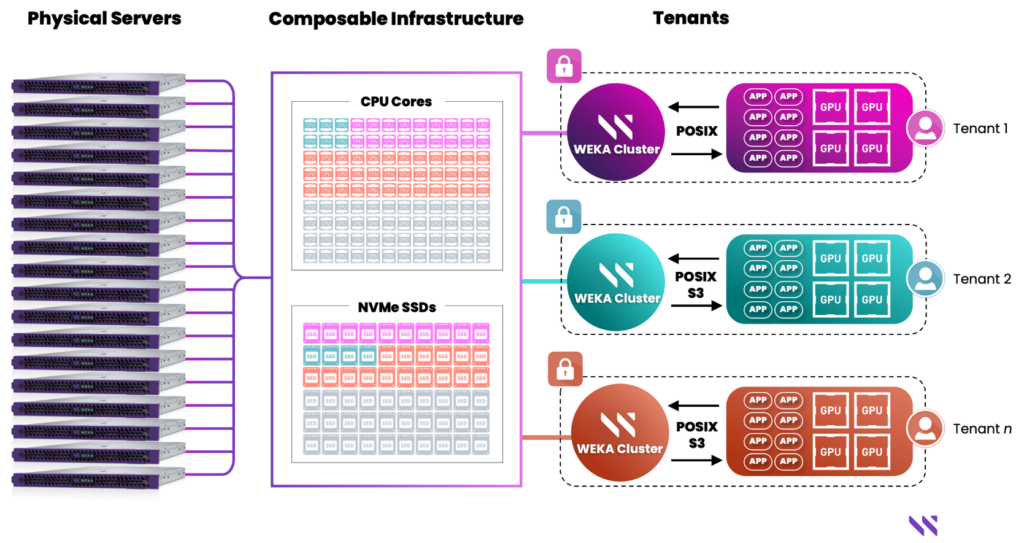
Each tenant has unique encryption keys and authentication credentials, ensuring data is secure and isolated. Unlike traditional storage approaches to multitenancy, which often involve shared flash drives and weaker isolation, the WEKA Data Platform offers dedicated resources for each tenant, providing strong performance guarantees and secure domain separation, a crucial factor for service providers with untrusted tenants.
The physical and logical isolation WEKA offers is crucial in cloud computing and data security because it not only enhances protection against breaches and cyber threats but also ensures performance isolation, preventing the “noisy neighbor” effect. In a shared environment, one tenant’s heavy workload can negatively impact the performance of others. However, with composable physical isolation, resources such as CPUs, memory, and storage are dedicated, eliminating competition for resources and ensuring consistent performance. This is particularly important for mission-critical applications where performance reliability and data security are paramount. By physically separating components organizations can protect sensitive data, maintain high performance standards, and prevent disruptions caused by resource contention.
Key Capabilities Include:
- Physical Tenant Isolation: Each tenant cluster operates independently, with dedicated drives, cores, and memory, ensuring no resource sharing between tenants. This isolation enhances both security and performance.
- Scalability and Efficiency: WEKA’s solution can support up to 110 tenants per Kubernetes server and up to 150,000 total tenants, allowing significant scalability without compromising performance.
- Fast and Flexible Deployment: Cluster creation takes just a few minutes, enabling CSPs to rapidly deploy resources as needed, with automated resource allocation that eliminates the inefficiencies of overprovisioning.
WEKA’s Composable Clusters provide a breakthrough solution to multitenancy challenges by allowing multiple WEKA clusters to be deployed on the same hardware infrastructure. Leveraging Kubernetes, this approach enables WEKA customers to segment data storage for different tenants, business units, or organizations while maintaining physical isolation, independent encryption, and dedicated resources for each tenant.
Secure and Efficient Cloud Operations
In today’s landscape, the true value of multitenancy lies in the ability to share resources efficiently while maintaining high performance, security, and cost-effectiveness. However, not all multitenant architectures are created equal. Some models, like those that isolate tenants to completely separate physical server environments, or fail to leverage the full benefits of shared infrastructure, leading to inefficiencies and missed opportunities for optimization. Going back to the family plan analogy from earlier, How would you feel if that family plan only supported 1 profile per TV? Perhaps they allow up to 4 profiles. That service, with all of your favorite shows and content, is bound to physical screens, forcing you to purchase a TV for every family member.
This is where the WEKA Data Platform stands out
Imagine signing up for a “multitenant” cloud service, but instead of truly sharing resources, each tenant is locked in their own isolated jail cell, completely cut off from the others. It’s like being in a prison where each cell is self-contained, with no shared spaces or opportunities to interact. You’re technically all in the same facility, but there’s no real sharing of resources that could make your situation more efficient or collaborative.
By combining physical and logical isolation with shared yet secure resources, WEKA enables cloud service providers to maximize efficiency, enhance performance, and maintain robust security—all while reducing costs and streamlining operations. WEKA’s Composable Clusters address these multitenancy challenges by offering a solution that balances efficiency, performance, and security. Just as an airline efficiently manages multiple passengers on the same flight while ensuring each has their own seat, WEKA enables cloud service providers to support numerous tenants on shared infrastructure without compromising performance or security. By providing physical and logical isolation, independent encryption, and dedicated resources for each tenant, WEKA ensures that every tenant receives top-tier service without the noisy neighbor effect, allowing CSPs to scale securely and efficiently in today’s demanding cloud landscape.
WEKA’s multitenancy capabilities deliver a powerful blend of efficiency, performance, and security, ensuring that cloud service providers can support multiple tenants seamlessly on shared infrastructure. By offering both physical and logical isolation, dedicated resources, and strong security features, WEKA optimizes resource utilization while guaranteeing high performance for all users. This approach not only reduces operational complexity but also allows GPU Cloud Providers to scale their services effectively, meeting the growing demands of today’s cloud environments.
